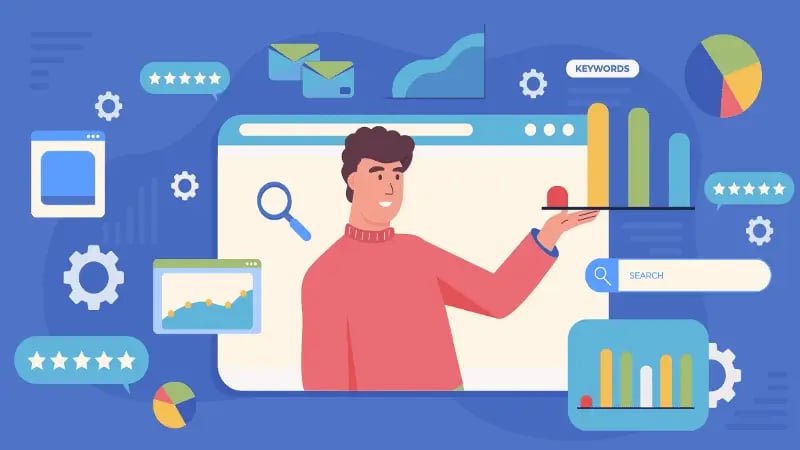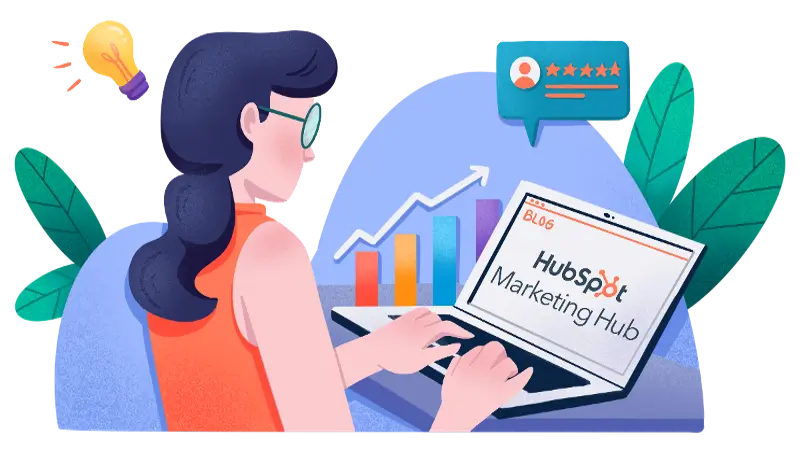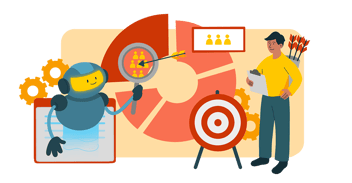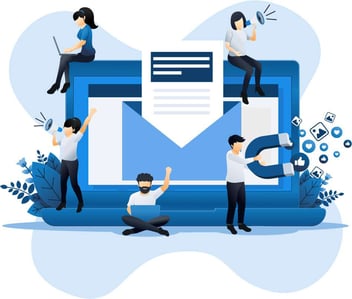Unlock SEO success: Learn how we use HubSpot Content Hub for SEO, boost rankings, increase organic traffic, and optimize our content for success.
The Power of Personalization: Boosting Sales With Customer-Centric SEO
Personalization is the new black in marketing. It's not just about knowing your customers; it's about showing them you know them. And the best way to do that is to personalize your marketing messages through customer-centric SEO.
So, if you're ready to take your marketing to the next level and implement the future of SEO, read on!

The Power of Personalization
In today's market, customers are bombarded with marketing messages from all sides. You need to personalize your marketing efforts to stand out from the competition. Personalization will help you connect with your contacts, prospects, or customers on a deeper level and make them more likely to do business with you.
Personalization is the process of tailoring marketing messages to individual contacts and customers. This can be done by using contact data to segment your audience and create targeted marketing messages relevant to each segment. Personalization can also be done by using dynamic content to deliver personalized messages on your website and emails.
Personalizing your marketing messages means you're not just sending everyone the same old generic messages. You're tailoring your messages to each contact based on their interests, needs, and past behavior. And that's a powerful way to boost sales and improve customer engagement.
Let's take a look at the ways personalization can help you boost your sales, improve your customer engagement, and increase your brand awareness:
Increased Sales
Personalization can help you increase sales by making your marketing messages more relevant to your customers. When your contacts feel like you're speaking to them directly, they're more likely to be interested in what you say and buy from you.
A study by Salesforce found that customers who receive personalized marketing messages are 40% more likely to repurchase from a company.
Improved Customer Engagement
Personalization is instrumental in customer engagement as it makes your customers feel like they're valued. When your customers feel like you know them and are interested in what they say, they're more likely to stick around and do business with you.
A study by Experian found that personalized emails had a 19% higher open rate and a 69% higher click-through rate than non-personalized emails.
Increased Brand Awareness
Personalization can help you increase brand awareness by making your brand more memorable. When your customers see your brand in a personalized way, they're more likely to remember it and think of you when they're ready to buy.
Improved Customer Loyalty
Personalization can even help you improve customer loyalty by making your customers feel like they're part of a community. When your customers feel part of something special, they're likelier to stick with you for the long haul.
A study by McKinsey found that customers who feel like they are being treated as individuals are 70% more likely to recommend a company to their friends and family.
Challenges in Personalization
While personalization is a must-do in modern marketing, many businesses still fail to personalize their campaigns effectively. This is likely because of the challenges associated with personalization. One challenge is collecting and managing the customer data you need to create customer profiles. Another challenge is that personalization can be time-consuming and expensive.
That said, while personalization can be challenging to achieve, it's paramount that businesses get it right. Personalization is becoming increasingly important in today's marketing landscape. As customers become more accustomed to personalized experiences, companies that fail to personalize their marketing efforts will likely fall behind. The future of personalization is bright, and businesses that embrace it will be well-positioned to succeed.
How to Personalize Your Marketing Efforts
Personalization is a powerful tool that can help you improve your marketing results. That said, it can be challenging to know where to start. Fortunately, we've got you covered.
There are three overarching steps involved in personalizing your marketing efforts:
-
Collect customer data.
-
Segment your audience.
-
Deliver personalized messages.
Let's take a closer look at each:
1. Collect Customer Data
The first step in personalizing your marketing efforts is to collect customer data. This data can include customer names, email addresses, purchase history, and interests. You can collect this data from various sources, such as your website, email marketing campaigns, and social media.
There are several ways to use customer data to personalize your marketing efforts. Here are a few examples:
-
Customer names: Personalizing your marketing messages with customer names is a simple way to make your customers feel like you're speaking to them directly. For example, you could use a customer's name in your email subject line or the body of your email.
-
Interests: Personalizing your marketing messages with customer interests is another way to make your customers feel like you're speaking to them directly. For example, you could show customers products they've previously viewed on your website or email them a special offer for a product they've shown interest in.
-
Purchase History: Personalizing your marketing messages with customer purchase history is a great way to cross-sell and upsell your customers. For example, you could email customers who have purchased a product with a special offer for a related product.
You might also like:
3. Segment Your Audience
Once you've collected customer data, you can segment your audience. This means dividing your customers into groups based on shared characteristics. For example, you could segment your customers by:
-
Demographics: Age, gender, location, and income.
-
Behavior: Purchase history, website activity, and social media engagement.
-
Attitude: Brand loyalty, purchase intent, and willingness to spend.
It's important to note that customers can (and often should) be segmented by multiple criteria. So don't just segment your audience by one. By using multiple criteria, you can create more targeted segments. Additionally, your audience will change over time, so you must revisit your segments regularly and adjust as needed.
Finally, remember that several tools help you segment your audience. Experiment with different tools to find the ones that work best for you.
4. Deliver Personalized Messages
Once you've segmented your audience, you can start delivering personalized messages. This means sending different marketing messages to each segment of your audience. For example, you could send an email with a special offer for a product a customer has shown interest in.
There are a few different methods and forms of personalized messages that you can deliver, including:
-
Dynamic Content: Content marketing drives growth, and dynamic content is a great way to personalize your marketing messages without creating separate marketing messages for each audience segment. Dynamic content can be used to deliver different content to customers based on their interests, purchase history, and other factors.
-
Social Media: Social media is another excellent way to engage with your customers personally. By responding to customer comments on your social media posts, sharing customer testimonials, and running social media contests, you can build relationships with your customers and make them feel like they're part of a community.
-
Customer-Centric SEO: Customer-centric Search Engine Optimization (SEO) helps ensure the right people see your personalized content. Using keywords and phrases that your target audience is likely to use when searching for information can help your website rank higher in search results when people search for those keywords and phrases.
Achieving Personalization with Customer-Centric SEO
Let's look closer at Search Engine Optimization (SEO) and being customer-centric.
Customer-centric SEO is a process of optimizing your website content for search engines in a way that focuses on the needs of your customers. This means creating relevant content for your target audience and using keywords and phrases they're likely to use when searching for information.
There are many benefits to customer-centric SEO. For example, it can help you:
-
Improve your website's ranking in search results: When optimized for the right keywords and phrases, your website is more likely to appear higher in search results. This translates to increased visibility, allowing a broader audience to discover the information they seek quickly.
-
Increase website traffic: Higher search engine rankings can bring more traffic to your website, increasing brand awareness, leads, and sales.
-
Improve customer engagement: When your website provides relevant content that is easy to find, your customers are more likely to engage with your brand. This can lead to increased loyalty, repeat business, and positive reviews.
There are several things you can do to implement customer-centric SEO, including:
-
Create content relevant to your target audience: Craft your content with your target audience in mind, considering their interests and needs. Ensure that your content is well-crafted, informative, and captivating to keep them engaged.
-
Use the right keywords and phrases: When writing content, use keywords and phrases that your target audience will likely use when searching for information. You can use various tools to help you find the right keywords, such as Google's Keyword Planner.
-
Make your website easy to use: Ensure that your website is user-friendly, with content that is easily accessible. Use simple language, avoiding industry jargon that may confuse your audience.
-
Keep your website up-to-date: Keeping your website current with the latest information is crucial for retaining customer interest and encouraging return visits.
Customer-centric SEO is an integral part of Content Marketing in SEO. Focusing on your customers' needs can improve your website's ranking in search results, increase website traffic, and improve customer engagement.
Are you still trying to figure it out? Here are some additional tips for implementing customer-centric SEO in your personalization efforts:
-
Use social media to listen to your customers: Social media provides a valuable opportunity to gain insight into your customers' interests. Take note of the questions they ask, their challenges, and the products or services they seek. By actively listening to your customers on social media, you can tailor your marketing efforts to meet their needs and preferences, increasing engagement and loyalty.
-
Use analytics to track your results: Use analytics to track the results of your SEO efforts. This will help you see what is working and what is not. You can then make adjustments to your strategy as needed.
-
Be patient: SEO is a long-term strategy. It takes time to see results. Don't get discouraged if you don't see results immediately. Keep at it; you will eventually see the benefits of customer-centric SEO.
By now, you should have a pretty solid understanding of why personalization matters and how you can achieve it, but understanding isn't the same as doing. At the core of all marketing campaigns are the tools we use. After all, it's the 21st century–if you aren't using technology, what are you doing?
Ultimately, your tools and platforms are as essential as your marketing strategies. So, it's crucial to find a tool that can help you achieve your personalization efforts; and we've got the one for you.
Leveraging HubSpot Marketing Hub
One platform leading the charge in personalization is HubSpot–specifically, HubSpot Marketing Hub, a marketing software suite. With HubSpot, you can collect customer data, segment your audience, create personalized marketing messages, and track your results.
With the HubSpot platform, it's easier than ever for companies to personalize their content–starting with collecting customer data.
Collect Customer Data
HubSpot Marketing Hub can help businesses collect customer data from various sources, including their website, email marketing campaigns, and social media. This data can segment your audience and create personalized marketing messages.
The platform can collect customer demographics, interests, and purchase history data. This data can then be used to segment customers into groups, such as "new customers," "repeat customers," and "high-value customers." Businesses can then create personalized marketing messages for each group of customers. For example, a company could send a new customer a welcome email with a discount code or send a repeat customer a special offer on a product they have previously purchased.
Audience Segmentation
HubSpot Marketing Hub can help businesses segment their audience based on various factors, including demographics, interests, and purchase history. This allows businesses to send more relevant marketing messages to each audience segment.
For example, a business could segment its audience by location, industry, or job title. This would allow the company to send more relevant marketing messages to each segment of its audience. Suppose you're working with a business that sells software. In that case, you could send a marketing message about a new software product to companies in the technology industry.
Personalized Marketing Messages
HubSpot Marketing Hub can also help businesses create personalized marketing messages using various tools, such as dynamic content and email templates. This allows companies to deliver content that is relevant to each contact. For example, HubSpot Marketing Hub can dynamically insert a contact's name into an email message. This makes the email message more personal and likely to be opened and read.
HubSpot Marketing Hub also includes software to help businesses develop personalization messages in a variety of mediums:
-
Email marketing: With HubSpot Marketing Hub, businesses can create and send personalized emails using its email marketing software. This feature allows companies to send welcome emails, abandoned cart emails, and other personalized emails tailored to each customer's needs and interests.
-
Website personalization: With the website personalization software in HubSpot Content Hub, businesses can tailor their website content to fit each visitor's interests, demographics, and other factors. This means that different visitors can see different types of content, making their experience more personalized and engaging.
-
Social media marketing: With the social media marketing software in HubSpot Marketing Hub, businesses can effortlessly engage with their customers on various social media platforms, including Facebook, Twitter, and LinkedIn. This software allows businesses to post updates, run contests, and interact with customers, strengthening their brand and building lasting relationships.
4. Tracking and Reporting
An instrumental feature, HubSpot Marketing Hub, can help businesses track the results of their marketing efforts, so they can see what is working and what is not. This information can be used to improve businesses' marketing strategies over time. For example, HubSpot Marketing Hub can track the number of website visitors, the number of email subscribers, and the number of leads generated. This information can then be used to see which marketing campaigns are most effective and which need to be improved.
5. Customer-centric SEO
Finally, HubSpot Content Hub enables customer-centric SEO by providing tools to help businesses create content relevant to their target audience and optimize their website for search engines. For example, HubSpot Content Hub can help companies identify the keywords their target audience is searching for and then create optimized content for those keywords. This can help businesses improve their website's ranking in search engines, leading to more traffic and leads.
Marketing: Let's Get Personal
In today's highly competitive digital landscape, personalization has become a powerful tool to boost sales and enhance customer experiences. Businesses can forge stronger connections, drive engagement, and ultimately increase conversions by tailoring marketing strategies to individual customers. One key personalization aspect is customer-centric SEO, which ensures that the right content reaches the right people at the right time. Businesses can attract and retain their target audience by optimizing websites and online campaigns focusing on customer preferences and behaviors.
The power of personalization lies in its ability to create relevant and meaningful customer interactions. Businesses can gain deep insights into customer preferences, demographics, and browsing patterns by leveraging data and analytics. Armed with this knowledge, they can deliver personalized recommendations, offers, and content that resonate with customers personally. This enhances customer satisfaction, builds loyalty, and drives repeat purchases.
Regarding implementing customer-centric SEO strategies, HubSpot Marketing Hub emerges as a top-notch tool. With its robust suite of features, HubSpot enables businesses to integrate personalization into their marketing efforts seamlessly. From intuitive analytics and audience segmentation to content optimization and automated workflows, HubSpot empowers marketers to create targeted campaigns that deliver real results. Its user-friendly interface and comprehensive support make it a valuable asset for businesses of all sizes.
Ready to get personal? Unlock the power of personalization with HubSpot Marketing Hub and convert visitors into loyal customers today!
This content is also available in:
- German: Personalisierung: Mit kundenorientierter SEO den Umsatz steigern
- Spanish: Personaliza tu SEO: ¡Más ventas con el poder de la personalización
- French: SEO Client-Centric : Booster vos Ventes par la Personnalisation
- Italian: Personalizza il SEO: vendite in crescita
- Romanian: Personalizarea: Stimularea vânzărilor cu SEO centrat pe client
- Chinese: 个性化的力量:以客户为中心的搜索引擎优化促进销售












Leave a Comment